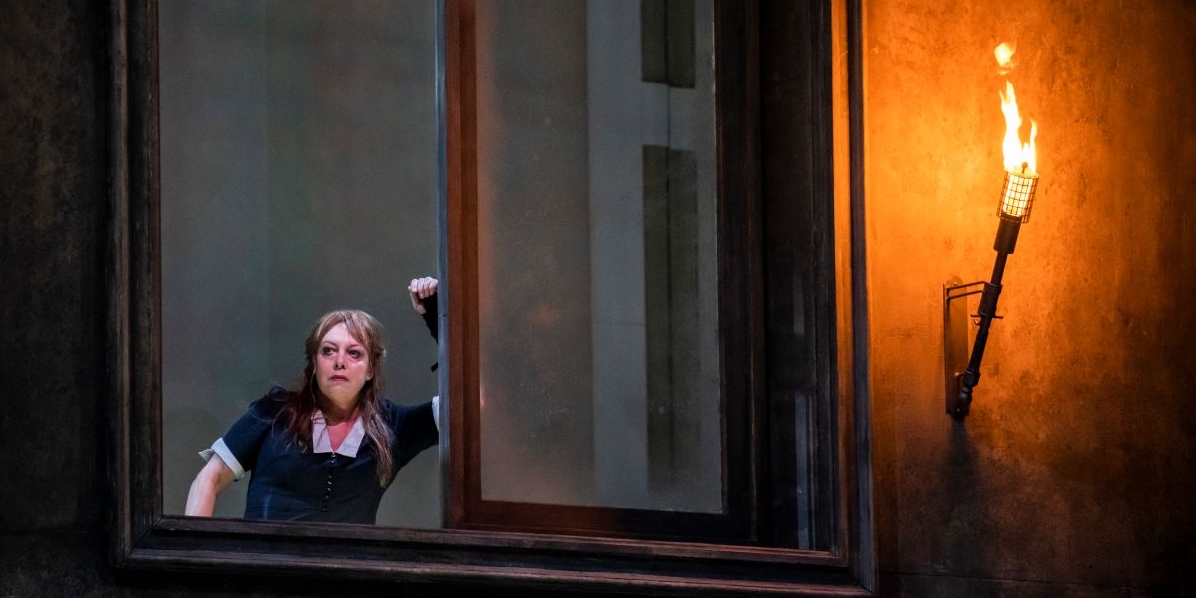Elektra is Richard Strauss’ first collaboration with Hofmannsthal, and the second of Strauss’ modernist operas – the first was Salome five years previously, (considered so shocking that only Dresden would stage it). Hofmannsthal’s sensationalist, modernist Elektra, based on Sophocles’ play, enthralled and horrified since its Dresden premiere in 1909. Both used the growth and understanding of Freudian psychology.
This is the first new production of 2024, and the last to be conducted by Sir Anthony Pappano, the outgoing musical director, in collaboration with German Christof Loy. The original 2020 premiere was cancelled due to the pandemic. The intentionally drab set, in the palace courtyard, puts the spotlight on the music, text and singers. Pappano and Loy focus on human conflicted characters. Pappano masters the huge orchestra with unrelenting searing intensity from start to finish, controlling the dynamics for his singers to be heard.
The music, described as ‘the colour of blood’, is one of the earliest works to use polytonality. It has atonal leitmotifs and discordant sections. The bloodier Elektra’s thoughts, the more the music becomes a dance, as in Salome.
Elektra is not an easy listen, not for beginners nor those who like a good tune. It starts with 4-note leit-motif ‘A-ga-mem-non’ which twists and distorts throughout as we understand the underlying obsessive thoughts. It is, Pappano says, ‘stressful to perform and stressful to listen to’ – 110 minutes of high -intensity thick and bloodthirsty music, with underlying menace in the bass.
Elektra focuses on the monologues and inner thoughts of three women. Strauss was not keen on tenors, so tenors have little music.
The Swedish soprano, 60 years old Nina Stemme, inhabits Elektra. She is outstanding throughout in this highly demanding vocally and physically role where she is on stage most of the 110 minutes performance. Right from the beginning monologue, she sings the four-note leit-motif ‘Agamemnon’ with extraordinary dolcissimo, pouring all the love for her father into those four notes. She follows with gorgeous warm phrasing, lovely quality top and bottom register as her obsession grows. She is a compelling actress. Dragging the axe which killed her father, she only lets her hair down for her final Totendanz (Death Dance) after Klytämnestra’s murder. Stemme gives a mesmerising, haunting performance, despite a damaged wrist.
American/Polish/German soprano Sara Jakubiak, in her ROH debut, as Chrysothemis, displays a lovely lyric soprano with a great future.
The 23-year-old Finnish soprano Karita Mattila was the first winner of the Cardiff Singer of the World. Now 63, she sings more mezzo roles. Looking sumptuous in vivid blue, standing out from the grey set, Mattila makes Klytämnestra unusually vulnerable. She still produces gorgeous phrases, dominating the stage by her presence. However, the bottom range lacks beef to be heard over the huge orchestra – a common problem for sopranos singing as mezzos. Klytämnestra, haunted by nightmares, sleepless, despite her opulent life, is racked with guilt needing superstitious rituals, paranoid with fear of Oreste’s vengeance, and her poisonous relationship with Elektra. Stupidly, she asks Elektra how to banish nightmares – STERBEN (DIE) Elektra replies, as Klytämnestra flees inside.
Polish bass-baritone Lukasz Golinski, as Orest has a gorgeous voice. His Recognition Scene with Elektra, is a highlight. Vocally matched, the joy and tenderness between them is palpable.
See this for Stemme and Mattila. Stemme will not be singing Elektra much longer. See this to hear Pappano’s emotionally-charged interpretation of the score, which grabs you from the first note, and does not let go until the last. A thrilling experience.
Music by Richard Strauss (1864-1949)
Libretto Hugo von Hofmannstha (adapted from Hofmannsthal’s 1903 play).
Directed by Christof Loy
Cast includes: Cast includes Nina Stemme, Karita Mattila, Sara Jakubiak, Lukasz Golinski, Charles Workman.
Until: 30 January 2024
Running time: Approximately 1 hour and 50 minutes with no interval.
Photo credit: Tristram Kenton

